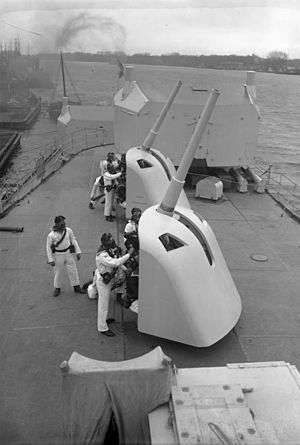8.8 cm SK L/45 naval gun
The 8.8 cm SK L/45 (SK - Schnelladekanone (quick loading cannon) L - Länge (with a 45-caliber barrel)) was a German naval gun that was used in World War I and World War II on a variety of mounts.
| 8.8 cm SK L/45 | |
|---|---|
 Anti-aircraft guns on light cruiser Königsberg, 1932 | |
| Type | Naval gun Anti-aircraft gun |
| Place of origin | German Empire |
| Service history | |
| In service | 1905?—45 |
| Used by | |
| Wars | World War I World War II |
| Production history | |
| Manufacturer | Krupp |
| Specifications | |
| Mass | about 2.5 metric tons (2.5 long tons; 2.8 short tons) |
| Length | about 4 meters (13 ft 1 in) |
| Shell | Fixed |
| Shell weight | 9–10 kilograms (20–22 lb) |
| Caliber | 88 millimeters (3.5 in) |
| Breech | vertical sliding-wedge |
| Elevation | Tbts LC/13: -10° to +25° MPL C/13: -10° to +70° SKC/30: -10° to +70°[1] |
| Muzzle velocity | 650 to 890 m/s (2,100 to 2,900 ft/s) |
| Maximum firing range | Horizontal: 14,100 metres (15,400 yd) at +43° Vertical: 9,150 metres (30,020 ft) at 70°[2] |
Description
The 8.8 cm SK L/45 gun weighed 2.5 metric tons (2.5 long tons; 2.8 short tons) and had an overall length of about 4 meters (13 ft 1 in). It used a vertical sliding-block, or "wedge", as it is sometimes referred to, breech design.
History
During World War I, the SK L/45 was used as anti-torpedo boat guns on all Imperial German Navy dreadnoughts and as main guns on torpedo boats and destroyers. The SK L/45 was also used to replace some of the 8.8 cm SK L/35 anti-torpedo boat guns on pre-dreadnought battleships. During the 1920s SK L/45 guns were temporarily fitted to the Deutschland-class cruisers and on Königsberg-class cruisers until the new 8.8 cm SK C/32 naval gun was available, with most ships being refitted by 1939. During the 1930s surviving SK L/45 guns were modified to use the same ammunition as the 8.8 cm SK C/30 naval gun and had similar performance.[3]
Ammunition
Fixed type ammunition with and without tracer, which weighed 15 kg (33 lb), with a projectile length of 355 mm (14.0 in) was fired. Ammunition Types Available:
- Armor Piercing (AP) - 10 kg (22 lb)
- High Explosive (HE) - 9 kg (20 lb)
- High Explosive Incendiary (HEI) - 9.5 kg (21 lb)
- Illumination (ILLUM) - 9.4 kg (21 lb)
See also
Notes
- Campbell, Naval Weapons of WWII, p.252.
- Campbell, Naval Weapons of WWII, p.252.
- Campbell, Naval Weapons of WWII, p.252.
References
- Die 8,8 cm Flugzeugabwehrkanone L/45 (8,8 cm Flak. L/45) in 8,8 cm Mittel-Pivot-Lafette C/1913 (8,8 cm M.P.L.C./1913). Berlin: E. S. Mittler. 1918. OCLC 635259544.
- Campbell, John (2002). Naval Weapons of World War Two. London: Conway Maritime Press. ISBN 0-87021-459-4.
- Gander, Terry; Chamberlain, Peter (1979). Weapons of the Third Reich: An Encyclopedic Survey of All Small Arms, Artillery and Special Weapons of the German Land Forces 1939–1945. New York: Doubleday. ISBN 0-385-15090-3.
- Hogg, Ian V. (1997). German Artillery of World War Two (2nd corrected ed.). Mechanicsville, PA: Stackpole Books. ISBN 1-85367-480-X.
- Rolf, Rudi (1998). Der Atlantikwall: Bauten der deutschen Küstenbefestigungen 1940-1945. Osnabrück: Biblio. ISBN 3-7648-2469-7.
- Rolf, Rudi (2004). A Dictionary on Modern Fortification: An Illustrated Lexicon on European Fortification in the Period 1800-1945. Middleburg, Netherlands: PRAK.